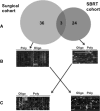Towards a molecular basis of oligometastatic disease: potential role of micro-RNAs
- PMID: 24968866
- PMCID: PMC4138440
- DOI: 10.1007/s10585-014-9664-3
Towards a molecular basis of oligometastatic disease: potential role of micro-RNAs
Abstract
Oligometastasis is a cancer disease state characterized by a limited number of metastatic tumors involving single or few organs and with biological properties that make them potentially amenable to locoregional antitumor therapy. Current clinical data show that they are potentially curable with surgical resection or/and radiotherapy. Yet, mechanisms of progression from primary tumor to oligometastasis, rather than to polymetastases, is lacking in detail. In the current review we focus on the role of micro-RNAs in the regulation of metastases development and the role they may play in the differentiation of oligometastatic from polymetastatic progression. We also discuss the analyses of metastatic samples from oligo-and polymetastatic patients, which suggest that oligometastasis is a distinct biologic entity regulated in part by micro-RNAs. In addition, a review of the known functions of oligometastatic-specific micro-RNAs suggest that they regulate multiple steps in the metastatic cascade, including epithelial-mesenchymal transition, tumor invasion, intravasation, distant vascular extravasation and proliferation in a distant organ. Understanding the role of micro-RNAs and their target genes in oligometastatic disease may allow for the development of targeted therapies to effectively conrol the spread of metastases.
Figures





References
-
- Giordano SH. Update on locally advanced breast cancer. Oncologist. 2003;8(6):521–530. - PubMed
-
- Hellman S, Weichselbaum RR. Oligometastases. J Clin Oncol. 1995;13:8–10. - PubMed
-
- Withers HR, Lee SP. Modeling growth kinetics and statistical distribution of oligometastases. Semin Radiat Oncol. 2006;16:111–119. - PubMed
Publication types
MeSH terms
Substances
Grants and funding
LinkOut - more resources
Full Text Sources
Other Literature Sources

